Army Art Posters and Prints
THE NONCOMMISSIONED OFFICER: IMAGES OF AN ARMY IN ACTION
CMH Pub 70-36;
18 full-color reproductions of paintings done by a team of Army artists that depict the history of the noncommissioned officer in the U.S. Army with an accompanying guidebook to the print set. The following prints are available in this print set. Individual prints may not be requested.
* View this publication online.
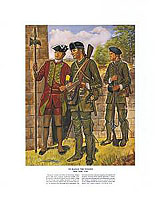
To Range the Woods - New York, 1760
During the colonial wars before the Revolution, Ranger patrols, often led by sergeants, performed valuable scouting missions for the British regulars trying to capture Canada from the French. Such military operations in heavily forested North America differed from Old World linear tactics. As opposed to their European NCO counterparts, who were used primarily to prevent straggling and maintain fire discipline, American NCOs had the opportunity to demonstrate small-unit leadership skills and independent judgment. Here Rangers, including an American sergeant about to set off on a raiding mission into French territory, discuss their mission with a regular sergeant of the British Army.
Eighteenth-century uniforms derived from contemporary civilian clothing on both sides of the Atlantic. British coats, waistcoats, and knee breeches were made of red cloth, the "national color" (leading to the nickname "lobsterbacks"). Long leggings or gaiters protected the legs. Variation in "facings" (cuffs, lapels, and lining) and the lace around the buttonholes distinguished different regiments. The British regular sergeant shown here is distinguished from private soldiers by the sash with facing stripe worn around his waist, and by the European halberd he carries instead of a musket-the halberd being more of a badge of office than a true weapon.
American Provincial units' uniforms appeared similar, but differed in color -- either blue or, in the case of the Rangers, green. Wilderness conditions caused practical modifications, such as discarding the standard cocked hat in favor of headgear less prone to get in the way in the woods. The longer European coat was replaced by a shorter jacket, and shoes and gaiters were abandoned in favor of moccasins and Indian cloth leggings.
NCOs in this era were distinguished from privates by having better -- quality uniforms. The Ranger sergeant wears worsted cording (instead of the even more ornate silver that an officer would wear) around his buttonholes. He is armed, like his men, with a cut-down musket and a tomahawk, which the Rangers favored instead of traditional European edged weapons.
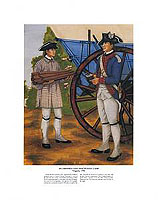
An Ordered and Disciplined Camp - Virginia, 1781
During the Revolutionary War, quartermaster sergeants prepared camp for General George Washington's army at the end of the day's march. The technical proficiency of these NCOs contributed directly to the speed with which Washington could move his regiments. This specialty, for example, enabled the continentals to march 350 miles so rapidly that they surprised the British at Yorktown in the battle that decided American independence. Here the quartermaster sergeant directs a private on the duty detail setting up tents, preparing fires, and otherwise readying a new bivouac for the night.
After several false starts, the Continental Army in 1779 finally adopted a plan for a national uniform of modified European style, using clothing imported from our French allies. The basic color for the coat was blue, with white for the waistcoat and breeches or overalls. Facings (cuffs, lapels, and collars) came in only four colors and were used to identify the regional grouping of states from which the regiment was raised. The red facing shown identifies this unit as coming from the Middle Atlantic states of Pennsylvania, Maryland, Virginia, and Delaware.
The quartermaster sergeant wears two white epaulets (a corporal would wear only one) and a sword to indicate his NCO status. His garments were of better quality than those issued to privates. Senior noncominissioned officers might further display their status by wearing elements common to officers' uniforms, such as silk epaulets. The private is wearing a heavy civilian-style linen smock to protect his issued uniform while on a duty detail. The hats are trimmed with white lace and with the symbol of Franco-American friendship, the "alliance" cockade, which combined the Continental Army's earlier, black version with the French Army's white. The French regiments in the Yorktown campaign also wore the cockade, but with the color arrangement reversed.
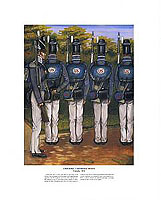
Checking Cartridge Boxes - Canada, 1814
During the War of 1812, the need for the Army to be drilled in the discipline of its European rivals again became apparent. The NCOs played a key role in the vigorous training required to turn civilians into soldiers capable of maintaining the linear formations and volley fire tactics typical of warfare in this period. Keeping ammunition and small arms in good condition was essential for such coordinated action. Here a corporal inspects the lead ball and paper cartridges carried by each soldier in his squad.
The American-made, smooth bore, .69 caliber musket issued to the individual soldier during the War of 1812, like the Revolutionary War French musket after which it was patterned, was effective only when fired in volleys. Volley firing, in turn, required absolute precision and teamwork. The primary duty of the squad leader was to ensure that his men kept their ammunition and weapons ready for action at all times. Only frequent inspections guaranteed results.
The corporal is identified by the single worsted epaulet on his right shoulder. He and the privates he is inspecting are wearing the winter fatigue jacket, trimmed with white worsted lace and buttons that identify it as an infantry uniform. The felt hats worn in earlier years have been replaced by leather caps, with infantry plates adorning the fronts. Each man wears black leather accoutrements of a cartridge box on the right hip and a triangular bayonet with haversack and wooden canteen on the left. The cartridge box contained the ammunition, which came in the form of a lead ball and individual gunpowder charge, rolled into a paper cartridge. In combat the soldier would bite the end off the cartridge and use the wrapper as wadding to hold the powder and ball in place.
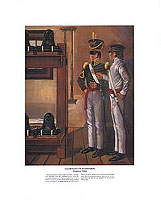
Guardians of Standards - Missouri, 1820s
Barracks inspection, always a major NCO duty, was especially important in the early nineteenth century. Strict discipline and standards were vital for a small Army trying to preserve a sense of professionalism despite being scattered across a vast frontier. In spartan barracks the NCOs had to enforce the clearly defined rules issued by the War Department. Here the regimental sergeant major and the first sergeant inspect the furniture and equipment in a typical small frontier post.
During the early 1820s the Army's regular regiments were scattered in small detachments across the frontier or in coastal fortifications, living in austere barracks. Four men slept in a double-tier bunk, two men on each level, sharing the straw-filled bedsack and blankets. The soldier had to use his knapsack to store all his possessions.
Regulations issued in 1821 provided a clearly defined set of standards for uniform dress which the NCOs used in evaluating their men. European styles still influenced the design of American uniforms, as seen in the high collar trimmed in worsted lace. The regulation specified a different color trim for each branch, including the buttons. The infantry, for example, wore white; the yellow seen here indicates artillery. Because the "Bell Crown" leather cap could be an agony on hot days, a workman's style forage cap would be introduced in 1828.
By 1820, the wearing of a sash and a sword (here, an 1819 Starr Contract model) served as badges of rank only for first sergeants and above. The 1821 regulations introduced to the uniform shoulder wings causing chevrons, rather than the traditional epaulets, to mark the uniform as that of a regimental sergeant major shown at the left. The summer fatigue dress worn by the company first sergeant on the right had no additional insignia.
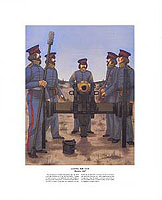
Laying the Gun - Mexico, 1847
The development of mobile field artillery gave the NCO a new and expanded role in the war with Mexico. Capable of rapid movement on the battlefield, individual fieldpieces now became the responsibility of noncommissioned officers. The NCO in charge of each gun was responsible not only for the care and placement of his piece, but also for the necessary teamwork of the gun crew, which might number as many as eight men. Here the gunner, a corporal, checks the aim of the six-pounder in one of General Zachary Taylor's batteries fighting in northern Mexico.
The evolution of the artillery into a more mobile, mounted arm, together with the heat and the dust of the Southwest, had an impact on the Army's uniforms during the Mexican War. The anticipated combat conditions precluded the more elaborate dress of Europe's military forces. Fatigue jackets and forage caps replaced the uniform coat and cap as campaign attire, with worsted chevrons on the former to indicate NCOs. As in earlier times, the color of the worsted lace and buttons identified the soldier's branch.
The crew of this 1841 model bronze six-pounder depended upon a routine as carefully choreographed as a ballet. Part of the eight-man team served with the limber and brought ammunition forward; the remaining five men, led by the gunner, manned the fieldpiece. The number one cannoneer is shown with a sponge-rammer on his toe and with a bucket of water to extinguish any remaining embers in the gun tube before the next round was loaded. The cannoneers were privates; the duty position of gunner held the rank of corporal, here seen checking to ensure that the gun is laid (aimed) correctly.
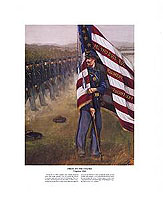
Dress on the Colors - Virginia, 1864
During the Civil War, sergeants and corporals preserved order when troops massed in line and assisted the officers by leading small units deployed for skirmishing. The color sergeant, performing what had once been an officer's duty, became the pivotal point in battle around which the regiments advanced and wheeled. Visible through the smoke and dust of battle, the sergeant's colors attracted the heaviest enemy fire and became the center of hand-to-hand combat. Here a regiment advances during the siege of Petersburg by aligning itself on the color sergeant.
Each infantry regiment had two colors, the Stars and Stripes and a second with a solid field bearing the national arms. Both flags were large, 6 by 6 1/2 feet, mounted on 9 1/2 foot pikes. The national colors, shown here, bore the regimental designation on the central stripe. It became the battle flag, the one usually carried into combat. The practice of inscrib-ing honors on the other stripes during the Civil War led to the modern custom of streamers. Each flag was borne by a color sergeant, a special duty position distinct from the company-level NCO. He was protected by the six corporals of the color party.
Sergeants in the Civil War were distinguished by their chevrons and trouser stripes and by their right to carry a sword, in this instance, a model 1840 NCO sword suspended from a shoulder belt and waist belt with distinctive eagle plates. Branch insignia included devices (for infantry, the light infantry horn) as well as the distinctive color of the uniform trim. Each foot soldier carried his possessions in a painted canvas folding knapsack with blanket roll strapped above. The knapsack was the first thing dropped before going into action. The soldier, however, was rarely separated from his haversack, which contained his rations, and from his tin canteen.
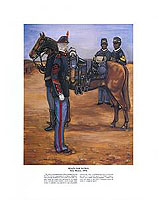
Ready for Patrol - New Mexico, 1870s
The Army's noncommissioned officers emerged from the Civil War with new requirements for technical competence. Their growing specialization was evident in the small, isolated coastal and frontier forts garrisoned by the regular forces. Each line soldier, whether a cavalry trooper, infantryman, or cannoneer, was supported by a growing number of technicians. Here, in a Southwest garrison, a cavalryman gets ready for a long desert patrol. An ordnance sergeant, a farrier, and a saddler check the equipment. A soldier's life could well depend on the NCO's competence during the course of a dangerous patrol.
New regulations prescribed in 1872 included improved fatigue clothing for general wear and a dress uniform influenced by contemporary Prussian practices. The basic branch of service was indicated both by trim colors (here yellow for cavalry and crimson for the ordnance department) and by insignia on the front of the forage cap worn in garrison. The trooper ready for patrol wears the less formal fatigue hat. His footwear, made at the federal penitentiary at Leavenworth, Kansas, consists of new, taller boots with tops that permit him to tuck in his trousers.
The trooper's mount bears a saddle pack in full marching order, ready for patrol. The pack includes small saddlebags for personal articles, extra ammunition, spare horseshoes, and nails; a cantle roll of shelter tent, wrapped around a blanket and extra clothing; and a pommel roll of caped overcoat, poncho, and forage sack with rations for the horse. Balanced on the near and far sides of the mount are the side line, lariat, picket pin, tin canteen, cup, and haversack with rations, the nosebag, and a grooming kit with brush and curry comb.
Each staff NCO had his function indicated on his chevrons-a leather knife insignia for the saddler, a horseshoe for the farrier, and a star for the ordnance sergeant. Other stripes on the sleeve indicated years of service and, when edged in white, wartime service.
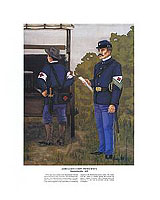
Ambulance Corps Proficiency - Massachusetts, 1895
NCOs supervised training in the Massachusetts National Guard Ambulance Corps, the Army's first specialized medical unit. This corps was one of several created in the nineteenth century to execute technical missions. The Ambulance Corps relieved regiments of the responsibility for transporting casualties to the field hospitals during combat. This change freed the infantry to continue fighting and increased the patient's chances of recovery. Here a sergeant directs the unloading of a litter from an ambulance during a training encampment.
By the end of the nineteenth century, most volunteer militiamen wore uniforms only slightly modified from the Regular Army's, generally relegating state-specific markings to buttons, belt plates, and cap devices. Because no federal counterpart organization existed for the Ambulance Corps portrayed in this picture, Massachusetts used insignia originally developed for personnel assigned to the hospital corps. The sergeant's rank is indicated by the chevrons of an acting hospital steward (green and white with the red Geneva cross) with matching stripes down his trousers by his 1840 model NCO sword.
The private's branch identification is in the form of the Geneva cross on his brassards and by two special items of individual equipment: a hospital corps pouch to carry his first-aid supplies (a modification of an obsolete leather cartridge box), and the hospital corps knife (a tool, not a weapon). Around his neck, and secured by the waist belt in front, is a leather litter sling.
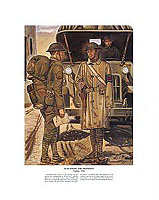
Sustaining the Offensive - France, 1918
Noncommissioned officers in the technical services assumed new responsibilities in World War I, with the appearance of new weapons such as tanks, airplanes, and poison gas. To support the infantrymen in this more technical environment, the Army formed specialized units within the division or as separate units. Here sergeants from the chemical corps and military police ensure that the route is clear of poison gas and stalled trucks before transportation corps drivers move supplies forward to sustain the offensive.
All personnel of the American Expeditionary Forces (AEF) wore a common service uniform made of heavy, rough, olive drab wool, consisting of breeches and a service coat with high collar. Bronze discs, adopted just before the war, indicated branch of service with company letter (on the left collar) and regimental number and "US" (on the right). The complexity of military specialties and grade structure produced a system of chevrons to indicate branch and duty position. The sergeant on the left has a benzine ring on crossed retorts to indicate membership in the chemical warfare service. Holding a whistle, the other sergeant, whose stripes are obscured by the slicker he wears, has his special service indicated by a brassard. Military police did not yet enjoy full status as a permanent branch, so his collar has no branch disc, but rather uses an insignia of a headquarters detachment with a red backing. Both NCOs carry the M1911 .45 caliber pistol. The chemical sergeant is in full pack and wears his gas mask in the alert position on his chest; the MP, normally stationed behind the lines for traffic regulation duty, is wearing his mask in the more comfortable position at his side.
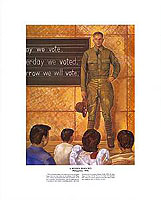
A Hidden Resource - Philippines, 1920s
NCOs assumed a major role in the civic action programs begun when the Army took over the defense of the Philippines. Always recognized for their skills as trainers, NCOs have frequently found themselves with the additional duty of teaching in local schools, promoting literacy, and working toward the elimination of disease. In the 1920s, the Army began working with the Filipinos to prepare for independence. Here the corporal assumes a new task, that of teaching citizenship skills to Filipino civilians.
Budget constraints and large stocks left over from World War I delayed official changes in uniforms during the interwar period. Soldiers with pride in their appearance quickly turned to private purchases of tailored garments as a "local option, " producing considerable variation in colors. These unofficial changes often anticipated official changes in Army uniforms. They most often occurred in overseas garrisons such as in the Philippines.
In 1920 a new simplified chevron system with olive drab stripes on a dark blue background came into being, reflecting a reduction in the number of grades to seven. Shiny brass collar insignia soon replaced the duller bronze. Black silk ties appeared, along with the Army custom of tucking them into the shirt. Every soldier in the tropics was allowed to wear an improved service or "campaign" hat, with characteristic "Montana peak" indentation. It was often the soldier's most prized possession, with its brim sometimes stiffened with sugar water. The corporal shown here, a squad leader, indicates his membership in the Signal Corps not only by collar insignia, but by the use of the orange and white (branch colors) cord around the base of his hat, a Stetson costing nearly a month's pay.
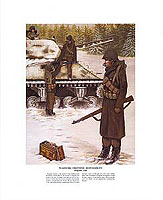
Teamwork, Firepower, Responsibility - Belgium, 1944
Sergeants became a vital element in the combined arms formations of World War II. The increase in firepower and growth in the size of a squad, from eight men led by a corporal to a twelve-man unit led by a sergeant, placed greater emphasis on leadership skills. In fact, the team shown here in late 1944 boasted greater combat power than a Civil War regiment. It pairs an M4 tank crew with a basic infantry squad, both commanded by sergeants. Its firepower includes the tank's cannon, several machine guns, a Browning automatic rifle (BAR), and the infantrymen's semiautomatic Garands.
Sergeants and corporals in combat units during World War II continued to wear chevrons of the 1920 pattern, although the Army had changed most of the other items of clothing. Olive drab wool shirts and trousers of a lighter shade were rapidly supplemented by heavier garments in cold weather. New replacements often entered the line with the M1943 olive drab field jacket, while "old hands" often retained the long overcoats issued when their units went overseas. Crews of the armored force had different apparel designed for use in vehicles, including a fiber and leather crash helmet with headset and M 1943 goggles instead of the "G.I. " (government issue) two-piece steel M1 "pot." Clothtop over-shoes designed to keep the cold and wet out of a soldier's footwear proved to be a temporary expedient, since it was impossible to march in them for any distance.
Individual field equipment, updated only slightly since World War I, was reduced to a minimum. The M1928 haversack, containing the " C " or "K" rations and personal items, often was left behind. Soldiers opted to stuff essentials into pockets instead. The rifle or automatic rifleman belt supported the canteen, first-aid packet pouch, and other items. Attached by equipment hooks, the bayonet for the Garand rifle and a folding entrenching tool were carried on the haversack.
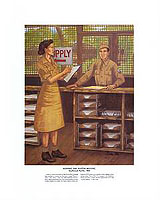
Keeping the System Moving - Southwest Pacific, 1945
America's mass mobilization to fight World War II brought large numbers of women into the newly created Women's Army Corps (WAC). They soon filled numerous administrative and technical positions, thus increasing the numbers of men, available for combat. For many of these women, promotion to NCO grade came quickly as they adapted to their military duties. Here a WAC first sergeant in the Southwest Pacific processes a newly arrived replacement on his way "up the pipeline" to the front.
Male and female soldiers in the rear areas in the Pacific theater wore the cotton khaki service uniform as basic attire. For comfort in the heat, local commanders had the option of allowing the troops to roll their sleeves up and leave their collars open, instead of wearing the regulation mohair necktie. As a protective measure in malaria areas, WACs could replace their skirts with slacks (or even altered male trousers). For comfort, female personnel traded their stockings and Cuban heel shoes for cotton anklets and high quarter russet field service shoes.
The garrison cap, worn with the khaki uniform and web belt, included cord edging braid in the branch colors (blue and red for the Adjutant General's Corps). The variation in shades and patterns of uniforms found in the theater reflected the inevitable loss of quality control as factory production surged in an attempt to keep pace with requirements. Significant variations also took place in the chevrons used to indicate NCOs. Wartime changes are reflected most noticeably by the increased role of the first sergeant, marked by the addition of a third "rocker," and by the creation of a parallel system of technical grades. These technical specialists were identified by a "T, " as worn by the technician, fourth grade, beginning inprocessing.
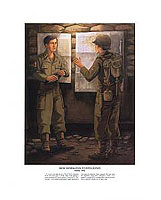
From Information to Intelligence - Korea, 1952
Five short years after the end of World War II, American NCOs were once again in combat. Much of the fighting in Korea resembled the trench warfare of World War I. Consequently, NCOs skilled in patrolling to gather information were especially important. Here a sergeant, first class, from the regimental headquarters intelligence section (S-2) debriefs a sergeant from a reconnaissance platoon just back from a nighttime mission into no-man's-land.
The uniforms worn in the Korean War were those of an Army in transition and, like the weapons employed, reflected innovations from the closing days of World War II. The herringbone twill (HBT) cotton clothing in a dark olive drab shade, originally intended as a work uniform, had become a practical battle dress, with large pockets providing a convenient means to store rations and other vital items. Similarly, improved field equipment, such as the M1945 combat pack depicted here, and the lighter .30-caliber M1 or M2 carbine quickly proved its worth, especially to experienced NCOs. The combat boot widely used in Korea was actually the old service shoe with a double-buckle cuff. Its flesh-out leather was no longer treated with dubbin, but instead was rubbed smooth to accept polish.
The proliferation of specialist positions after World War II resulted in a revision of grade structure and rank insignia in 1948. The new system identified combat and noncombat (or technical) functions by smaller size chevrons of reversed color scheme. Combat leaders, such as a sergeant from a reconnaissance platoon, now wore three stripes and one rocker in blue on a goldenlite background; contrasting colors like those worn by the sergeant, first class, on the left indicated noncombat duties.
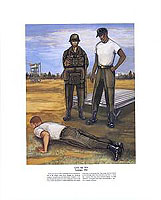
Give Me Ten - Georgia, 1960
NCOs have always been responsible for the physical fitness of the soldiers under them. Despite the increasing emphasis on technology and sophisticated weaponry in the post-Korean War period, the Army continued to believe that every soldier was at heart a combat infantryman who needed to be at his or her physical best. Here at the Airborne School at Fort Benning, where every instructor is an NCO, a "black hat" sergeant, first class, directs physical training. A young lieutenant, seeking his jump wings, does push-ups to "pay" for a training infraction.
The instructor in this picture wears the fatigue uniform without shirt for "PT" (physical training). Fatigue clothing, now accepted as field dress, underwent yet another change when the Army returned to a garrison environment and sought to standardize its uniforms with other services. Now termed "utilities," fatigues became dressier. Bellows pockets gave way to a simpler cut; plastic buttons replaced metal ones; and a smoother olive green sateen fabric became standard.
In 1954 "US Army" appeared as a tape above the left breast pocket, while chevrons, as shown on the private, first class, demonstrator, began to switch to the modern pattern of goldenlite on Army Green, with the new system of eagle insignia for specialists. Local options began to proliferate. The use of a tape over the right pocket bearing the soldier's last name soon became mandatory, but the instructor's baseball cap bearing bright miniature rank insignia and qualification badge never attained official status. Parachute jump boots, originally adopted as a practical ankle support, became a symbol for airborne troops. Even after the boots were authorized for all personnel in 1952, paratroopers took pride in distinctively blousing their boots.
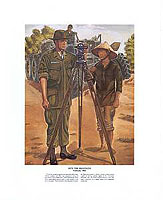
Into the Provinces - Vietnam, 1965
Technically trained sergeants and specialists built roads, schools, hospitals, and other vital installations during the early phase of the Vietnam War. These experienced, career NCOs applied their technical skills to a new purpose-civic action programs. These measures were designed to support the Saigon government's efforts to forge a modem nation capable of denying popular support to the Communist insurgents. Here the master sergeant surveys a new road under construction into a remote region of the Vietnamese countryside.
Deployment into the provinces of Vietnam called for innovation in field service uniforms. A new tropical version appeared, based on the parachute clothing of World War II. Originally perfected for counterinsurgency operations, the new clothing was issued to rotating personnel as it became available. It brought back the use of cargo pockets and other utilitarian features. Some original touches, such as shoulder loops, waist tabs, and exposed buttons, soon had to be eliminated. The uniform was accompanied by fast-drying boots with nylon uppers. The first issue of the new hot-weather boot had no ankle reinforcement or protection against punji stakes.
Headgear even cooler than the recently developed olive green baseball cap became a necessity. The latter, still worn by the heavy-equipment operator, could not block the hot rays of the Vietnamese sun. The master sergeant checking the work of the road-building crew wears an early version of the "bush hat. " At this stage of the war, troops still wore the white underwear and brightly colored name tapes and rank and other insignia more appropriate for a garrison environment.
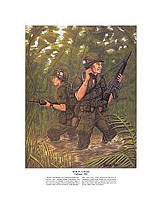
War in a Maze - Vietnam, 1969
Because of the shortage of NCOs during the Vietnam War, first-term "buck" sergeants, normally squad leaders, often found themselves in command of combat patrols. Many of these men were graduates of the Noncommissioned Officers Candidate Course. Known in the field as "shake and bakes," these instant NCOs quickly mastered the difficulties of warfighting in rugged terrain. Reliable radio communications gave them immediate access to firepower never before available to junior leaders. Here a patrol leader under attack calls his fire support center for assistance.
Modifications in basic weapons, clothing, and equipment came rapidly as the Army tried to solve the special problems encountered in hot and humid Vietnam. The improved tropical combat uniform in ripstop fabric became available, as did spike-resistant boots. The load of the infantrymen also changed as the extra food and clothing carried on their web gear or in nylon rucksacks was replaced by plastic canteens of water and by munitions: fragmentation and smoke grenades, mines, trip flares, and extra magazines of 5.56-mm. ammunition. The increase in firepower of a squad revolved around the new, lighter-weight M16A1 rifle with 20-round magazine. Modified slings and bandoleers holding extra ammunition exploited its fully automatic potential.
The introduction of olive green underclothing and towels (used commonly as sweat rags) and subdued chevrons reduced the chances of giving away one's position to the enemy. Individuals sometimes dealt with the stress of their tours of duty by personalizing the uniform through the use of local Vietnamese jewelry and slogans written on the camouflage helmet cover.
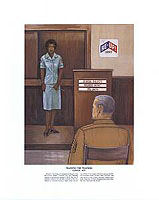
Training the Trainers - CONUS, 1975
Advances in technology and management techniques in the post- Vietnam Modern Volunteer Army put continuing emphasis on profes-sional training for NCOs. The Army's traditional instructors now alter-nated as students as well. This emphasis on classroom training at regular career intervals was reflected in the creation of the Noncommissioned Officer Educational System (NCOES). Here a specialist, sixth class, lectures a class of NCOs, including a sergeant major in the foreground, on records management procedures under The Army Functional Files System.
The end of the Vietnam War and the draft signaled the return of an all-volunteer military. The 1970s were years of transition, as the Army sought to adjust to changing attitudes and conditions while still retaining a sense of tradition. For example, the ratio of female soldiers, a perma-nent part of the military establishment since World War II, saw a dramatic increase.
Just as field dress changed, so did apparel worn in garrison duty. Uniform variations had been developed for both men and women to enhance pride by providing more stylish attire, including the shift from olive drab to the new shade of Army Green, derived from the distinctive rifleman's color of the nineteenth century. Rank insignia evolved as the number of senior NCO grades increased. For example, the traditional position of sergeant major returned as a rank. Two time-honored devices were used -- the star indicated the rank, while the addition of a wreath indicated the duty position of command sergeant major. Enlisted disc insignia were still worn on the collar. Here the instructor's branch, the Women's Army Corps, is reflected by the Greek goddess of wisdom, Pallas Athena, worn on the left collar, with the "US" on the right.
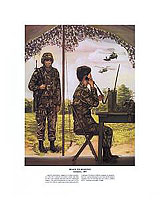
Ready to Respond - Germany, 1987
Leadership and technical competence are dual characteristics of the NCO, especially in modern combat when units are often widely separated and armed with very sophisticated weapons. The Army recognized the fact that today's NCOs must be both effective leaders and skilled technicians when it eliminated the distinction between sergeants and specialists. Here the corporal preparing for guard duty and the sergeant communicating with the home base are modern, complete NCOs, combining both types of skills.
During the 1980s the Army underwent one of the most intensive peace-time technological transformations in its history. From the M1 Abrams tank to the field ration, the Meal, Ready to Eat (MRE), the most basic items of Army life were modernized. Increased emphasis on the need for every soldier to be prepared for combat is reflected in the fact that both soldiers wear the battle dress uniform (BDU), which incorporates many features to enhance survivability in combat. These garments for the first time provided all troops with camouflage, while the properties of the fabric itself and the use of miniature rank insignia on the collar reduced the chance of detection. Preparation for battle was extended to an improved protective vest and new style of helmet. The fast-drying nylon Load Bearing Equipment (LBE) and redesigned boot drew upon the best features of commercial hiking and camping gear to extend the soldier's capabilities in a field environment.